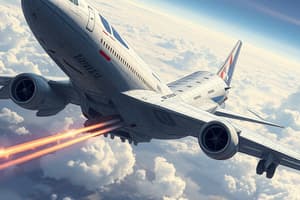Podcast
Questions and Answers
What is the importance of having a definite plan before starting any work in designing an airplane?
What is the importance of having a definite plan before starting any work in designing an airplane?
- To avoid mistakes and unnecessary work (correct)
- To complicate the design process
- To speed up the design process
- To increase the cost of manufacturing the airplane
Apart from meeting structural requirements, what other responsibilities should a designer fulfill during the design process?
Apart from meeting structural requirements, what other responsibilities should a designer fulfill during the design process?
- Prioritizing passenger safety over economic factors
- Ignoring economic and safety perspectives
- Ensuring the aircraft is safe to operate and cost-effective to manufacture (correct)
- Meeting only operational specifications
What percentage of responsibility for aircraft accident prevention lies within the job of the aircraft designer?
What percentage of responsibility for aircraft accident prevention lies within the job of the aircraft designer?
- One third
- Three quarters
- Half
- Two thirds (correct)
What should be a good starting point for a designer when beginning to design an airplane?
What should be a good starting point for a designer when beginning to design an airplane?
Why is it important for a designer to consider both economic and safety perspectives during the design process?
Why is it important for a designer to consider both economic and safety perspectives during the design process?
What is claimed about the responsibilities of a designer regarding checking all design phases?
What is claimed about the responsibilities of a designer regarding checking all design phases?
What is the first step a designer should take when designing an airplane?
What is the first step a designer should take when designing an airplane?
In aircraft design, what is a full cantilever monoplane?
In aircraft design, what is a full cantilever monoplane?
What distinguishes a high wing monoplane from a parasol monoplane?
What distinguishes a high wing monoplane from a parasol monoplane?
What is the primary difference between positive stagger and negative stagger in biplanes?
What is the primary difference between positive stagger and negative stagger in biplanes?
How can a designer differentiate between a low wing and a high wing monoplane?
How can a designer differentiate between a low wing and a high wing monoplane?
What is an essential consideration in aircraft design regarding wing area distribution?
What is an essential consideration in aircraft design regarding wing area distribution?
Flashcards are hidden until you start studying
Study Notes
Selecting the Type of Airplane
- The design process begins with a clear goal and a structured approach to avoid mistakes and unnecessary work.
- A designer's responsibilities include meeting structural, operational, and performance requirements, as well as ensuring safety and economic viability.
Designer's Responsibilities
- A designer must meet the initial set objectives and requirements, including economic and safety perspectives.
- The designer is responsible for ensuring the aircraft is safe to operate and cheap to manufacture without compromising passenger safety.
Starting the Design Process
- A designer should start by defining the type of airplane to be designed, such as a trainer aircraft or commercial airliner.
- The designer should write down a set of specific specifications that can be used to design an airplane that meets the proposed design intentions.
Airplane Specifications
- Airplane specifications are more comprehensive than those for cars and include factors such as:
- Type of airplane (biplane or monoplane)
- Wing design (cantilever or semi-cantilever)
- Wing position relative to the fuselage (low, mid, or high wing)
- Wing variables (area, planform, airfoil, stagger, dihedral angle, etc.)
- Structural and material considerations
Studying That Suits You
Use AI to generate personalized quizzes and flashcards to suit your learning preferences.




